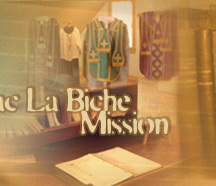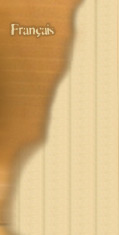Education/Schools/Students | Nuns | Oblates
Domestic Services | Sisters of Charity | Filles de Jesus | Letters | Letters 2 | Life at Lac La Biche | Propagation | Propagation 2
NUNS
Domestic Services
Host Making
Champagne's Direct Quotations taken from pages 147 and 293.
 The tasks for which the sisters were responsible were outlined in a summary at the end of their journal: washing the clothing of the missionaries and the linens of the church and chapel, as well as the house cleaning of the bishopric, the church and the portable chapels of the missionaries. They also took care of the making and washing all of the clothing of the Dunvegan and Lesser Slave Lake Missions. During the spring of 1882, they received a special little oven for the making of hosts, from Sr. Charlebois. Before then, as they were obliged to prepare all of the hosts for the missions of the vicariate, they had done so either by the fireplace or on the top of a stove. They had to hold out the long mould, somewhat similar to a long handled waffle iron. It was a very tiring job. They sometimes could not keep up with the demand.
The tasks for which the sisters were responsible were outlined in a summary at the end of their journal: washing the clothing of the missionaries and the linens of the church and chapel, as well as the house cleaning of the bishopric, the church and the portable chapels of the missionaries. They also took care of the making and washing all of the clothing of the Dunvegan and Lesser Slave Lake Missions. During the spring of 1882, they received a special little oven for the making of hosts, from Sr. Charlebois. Before then, as they were obliged to prepare all of the hosts for the missions of the vicariate, they had done so either by the fireplace or on the top of a stove. They had to hold out the long mould, somewhat similar to a long handled waffle iron. It was a very tiring job. They sometimes could not keep up with the demand.
Eventually, the Sisters of the Precious Blood, an order
of cloistered nuns who established themselves in the diocese, specialized
in production of hosts, and supplies were purchased from them, freeing the
sisters at the Mission from another chore. Bread too was purchased from the
town after the 1940s.
Food
Empty Cupboards page 87.
Towards the end of April of 1871, work was under way.
Once again, the crew took with them the maximum of food provisions from the
Mission, leaving the sisters with empty cupboards. The nuns' chronicles describe
how they had to depend on a fisherman to keep them supplied for their daily
needs. Courageously, they accepted the hardships and the work which was demanded
of them, were very thrifty and bore the difficulties.
Loom
Champagne’s Direct Quotations taken from pages 165, 181, 183…
Letting the children out had unexpected advantages. The sisters now had time to try out their new loom, which they had received the year before. Br. Bowes set it up for them. People came from all around to see it, as they had never seen one before. The sisters said it was the first one west of Red River. Faraud also made them a spinning wheel. The sisters saved pieces of old woolens, unraveling them, spun the yarn and wove it into blankets, shawls and rugs. A clever way of bringing in raw wool was devised in having incoming personnel carry it in their pillows; over forty pounds of wool was brought from St. Boniface. After arriving, the wool was traded for feathers. The sisters made woolen shirts for each of the brothers at the Mission, a warm blanket was given to Br. Bowes, in thanks for his precious aid to the sisters, and a carpet was woven for the Bishop Faraud’s Floor. The sisters did not forget Bishop Grandin and sent him a twenty yard length of carpet.
They had time to do some weaving. A square rag run, ten
feet square, had been sent to the chapel at Lesser Slave Lake and two and
one half yards of a heavy woven bedside rug had been sent to their Mother
Superior. Everyone worked on the latter, wanting to put a little of themselves
into the gift.
Our old Sr. Daunais has so actively turned the spindle
that Sr. Beliveau has been able, in spite of her usual chores, to weave forty-four
yards of beautiful and good flannel, to make warm shawls for our poor little
Indians.
Clothing
Champagne’s Direct Quotations 151, 225,
177.
Not only were the rules bent with respect to the religious
discipline, but material allowances had to be made because of the conditions
there. The sisters were wearing moccasins as they were unable to get their
usual shoes. Their aprons were not made of the usual blue striped fabric,
but of indienne, a cheap, study cotton widely available at that time. The
sisters also wore their heavy coats to go to mass or to go out and they wore
short capes with hoods rather than the usual hat and mantle, as they were
too poor to have anything else.
Not just depending on charitable gifts, the sister had
sold $21 worth of hand woven straw hats.
At Lac La Biche, there was no more sinew, no more hides,
no more buffalo, and no more moose, which meant no more shoes.
Laundry
Champagne's Direct Quotations taken from pages 149, 166, 295, 148, 296.
All of the work fell on the two remaining sisters, Sr.
Guenette and Sr. Tissier and the few remaining "données"
as it was becoming more difficult to find young women in Quebec who would
give themselves to the Grey Nuns, as they preferred to go the United States
and work. It is still remembered, around Lac La Biche, that young women usually
worked for the sisters at the convent, getting some schooling in exchange.
How many or if any were working at that time is not known. But these extra
hands for domestic work surely made a difference in the distribution of the
work load. In August of 1871, another nun, Sr. St. Michel (Rose-Délima
Prévost), arrived at Lac La Biche accompanied by two Tertiary Sisters.
They were joyfully welcomed by the other sisters…
There was plenty of work; the sisters would make all
of their own soap, as pioneer women did  everywhere.
A building, called "le lavoir" was set apart for the laundry. In
the forties, the children’s wash could be sent home with the mail and
a reduced boarding rate was charged, seven dollars instead of ten per month.
But there was still a lot of laundry to be done for the children and all of
the personnel at the mission. Laundering was a very big job, very hot and
steamy, and the laundress sister wore her costume, which to some seemed unbearable.
everywhere.
A building, called "le lavoir" was set apart for the laundry. In
the forties, the children’s wash could be sent home with the mail and
a reduced boarding rate was charged, seven dollars instead of ten per month.
But there was still a lot of laundry to be done for the children and all of
the personnel at the mission. Laundering was a very big job, very hot and
steamy, and the laundress sister wore her costume, which to some seemed unbearable.
In the meantime, the sisters had taken a day to launder
by the side of the lake. Although the weather might not have been ideal, they
had to make the best of it.
In 1870, Faraud had requested a sewing machine and a
washing machine for the sisters as they were responsible for making and mending
the clothes for the staff, and the woods were hard on garments. The sewing
machine had been received, but the little essentials for the seamstress had
been forgotten: sewing machine needles, thread and special machine oil. By
1872, they had received a washing machine.
The older girls would mend the clothing, replacing buttons
and mending tears, and were often responsible for their siblings. Usually,
mending was done on Saturdays. Although there was a sewing machine, it seems
to only have been used by one sister who was the seamstress.
Outdoor Oven
Champagne's Direct Quotations taken from pages 149, 174, 235, 293.
As their old stove with its oven was too small for their
needs, Alexis Reynard built them an exterior oven in 1873. It was sheltered
by a roofed building, large enough to include a room which served as a bakery
and as an occasional guest room.
Something must have happened to the outside oven that
summer as another one was built; according to Végréville, the
one Br. Alexis had built was too big. A brick oven was built by Br. Boisramé,
who made the bricks in August of 1881.
A charcoal oven was prepared by Moalic and Alexandre,
who were instructed on the technique by Br. Racette. The worn mill stones
were replaced.
Bread was baked regularly at the school. The oven
was kept in the larger of the play rooms, which, depending on the attendance
that year, was either the boys' or the girls' room. One man remembered how
good that bread smelled and how tasty it was. When the Sisters of Charity
first came to the Mission, they did not do the baking; a brother had that
job. Things gradually changed, however, as the sisters came to be recruited
from Alberta. The oven used to be outdoors, but with more modern ovens, it
became possible and practical to use the heat from the firing of the oven
to also heat the school building.
© 2003 Société
culturelle Mamowapik and the Lac La Biche Mission Historical
Society (All Rights Reserved)






